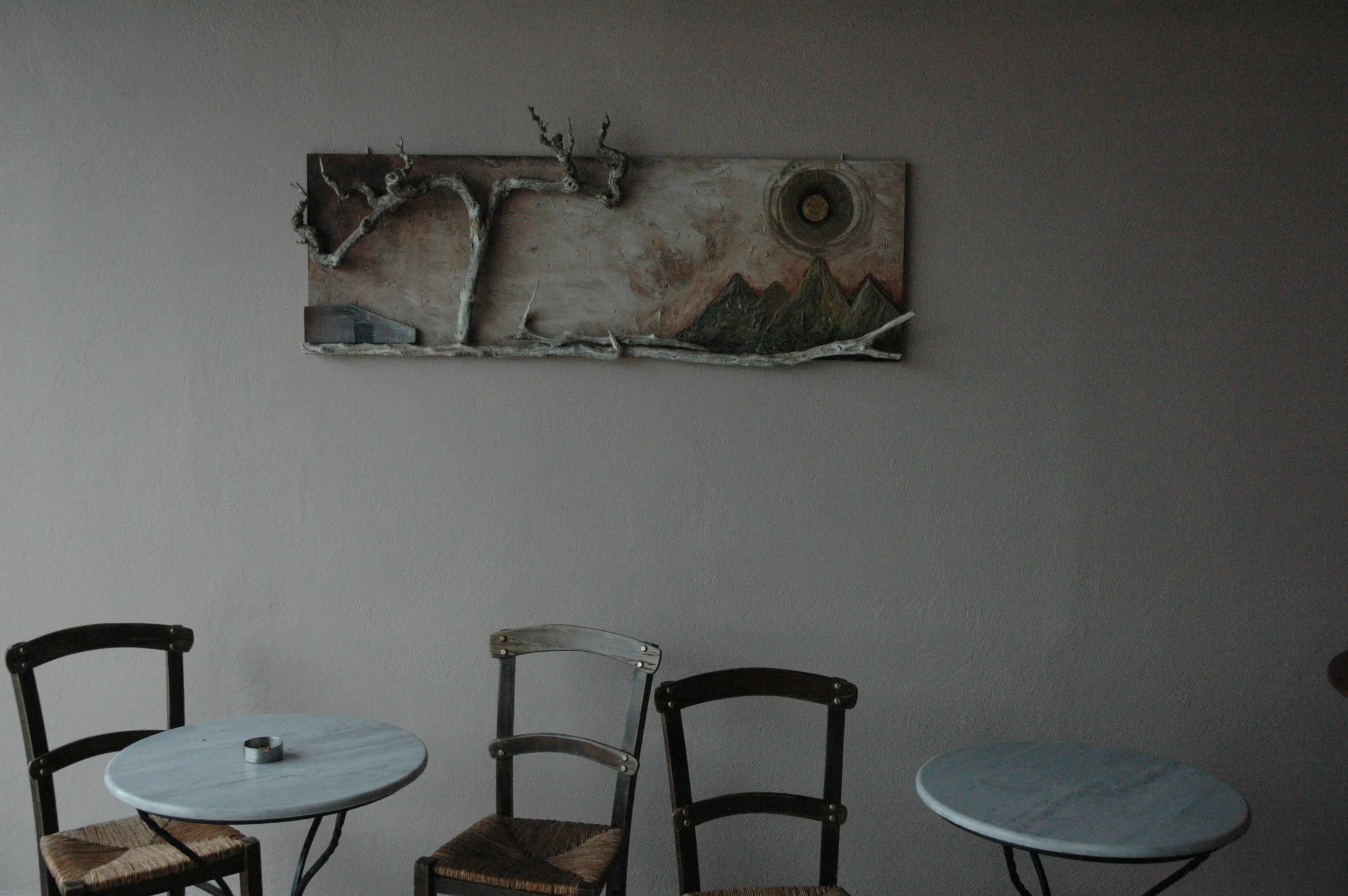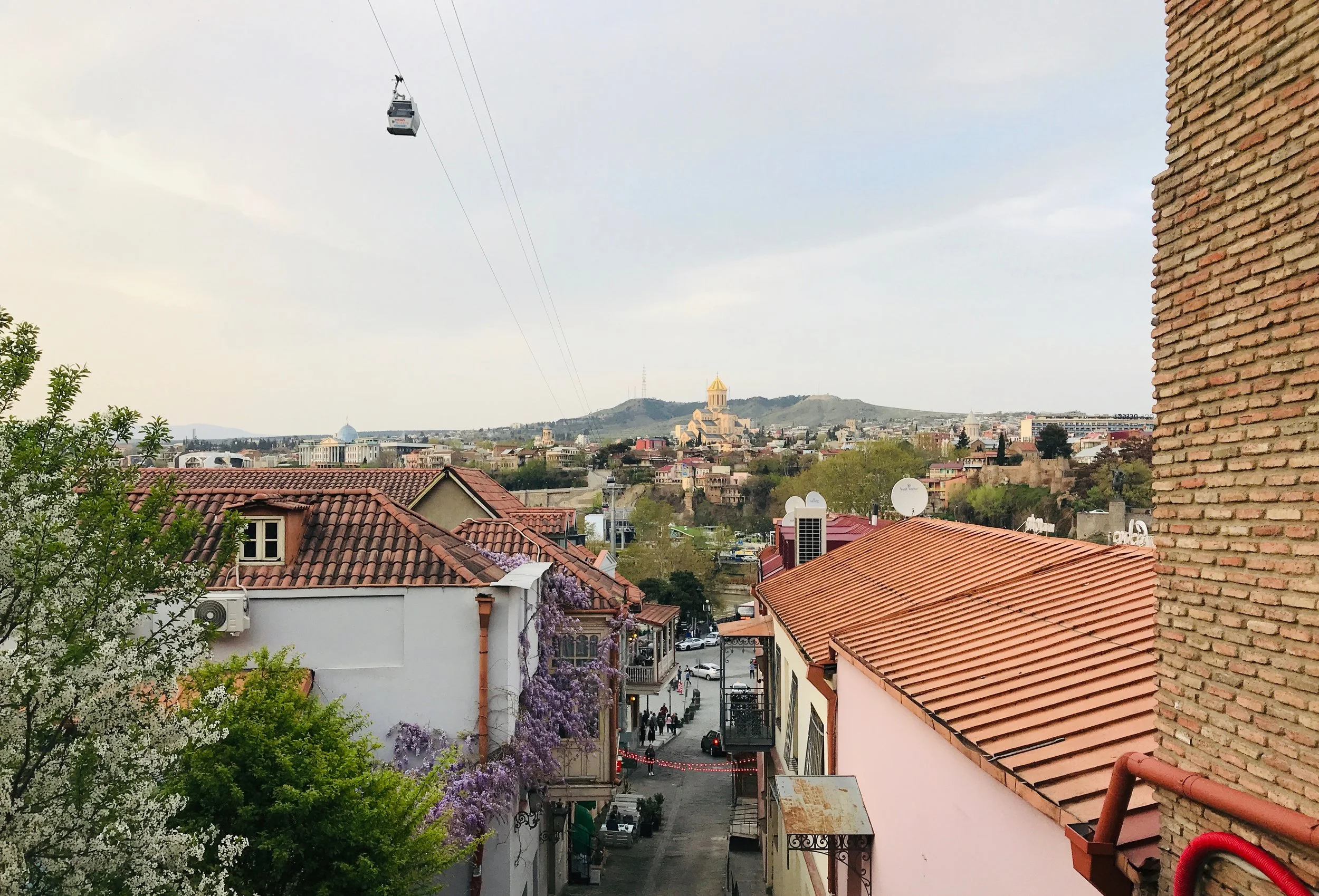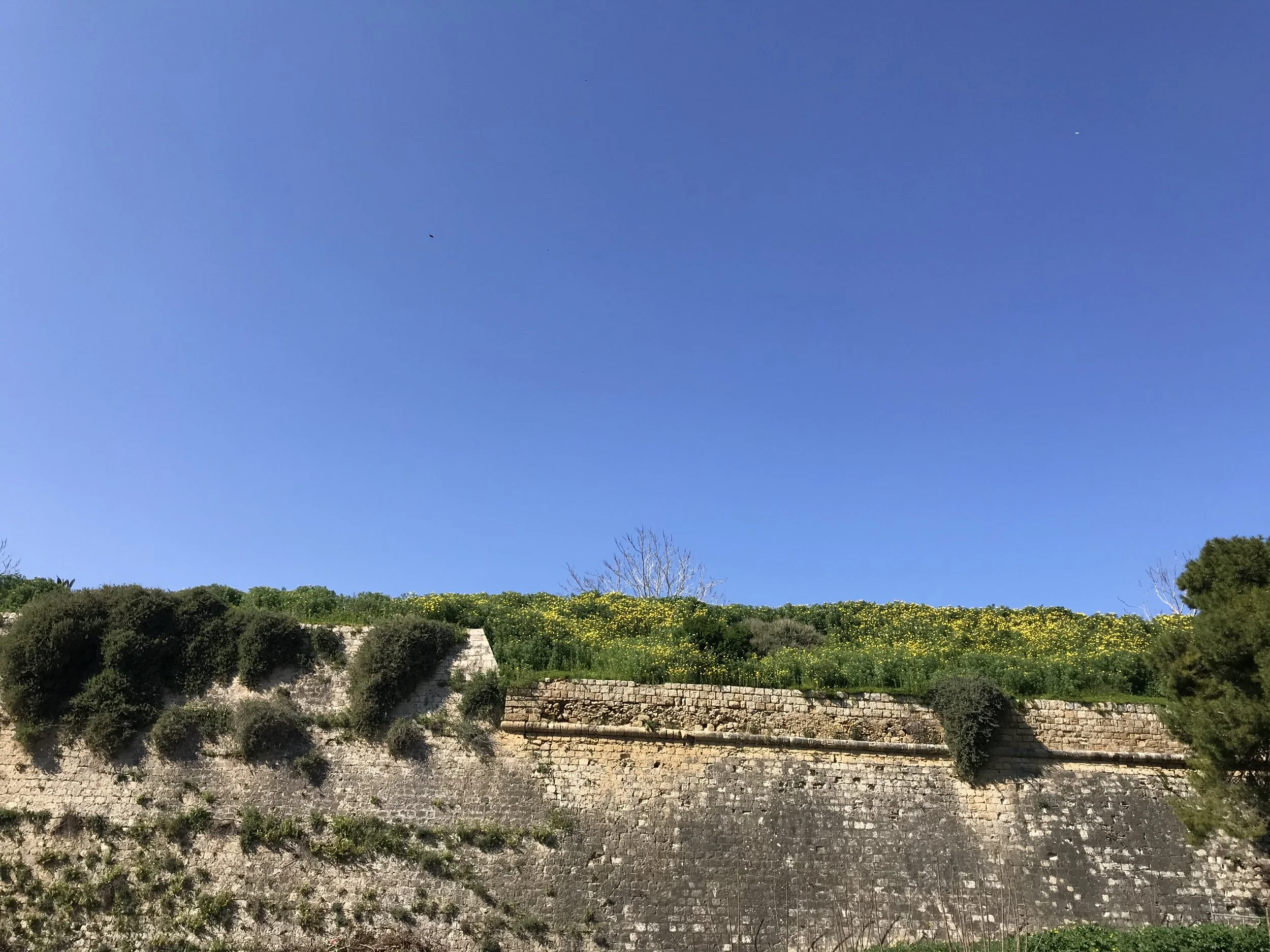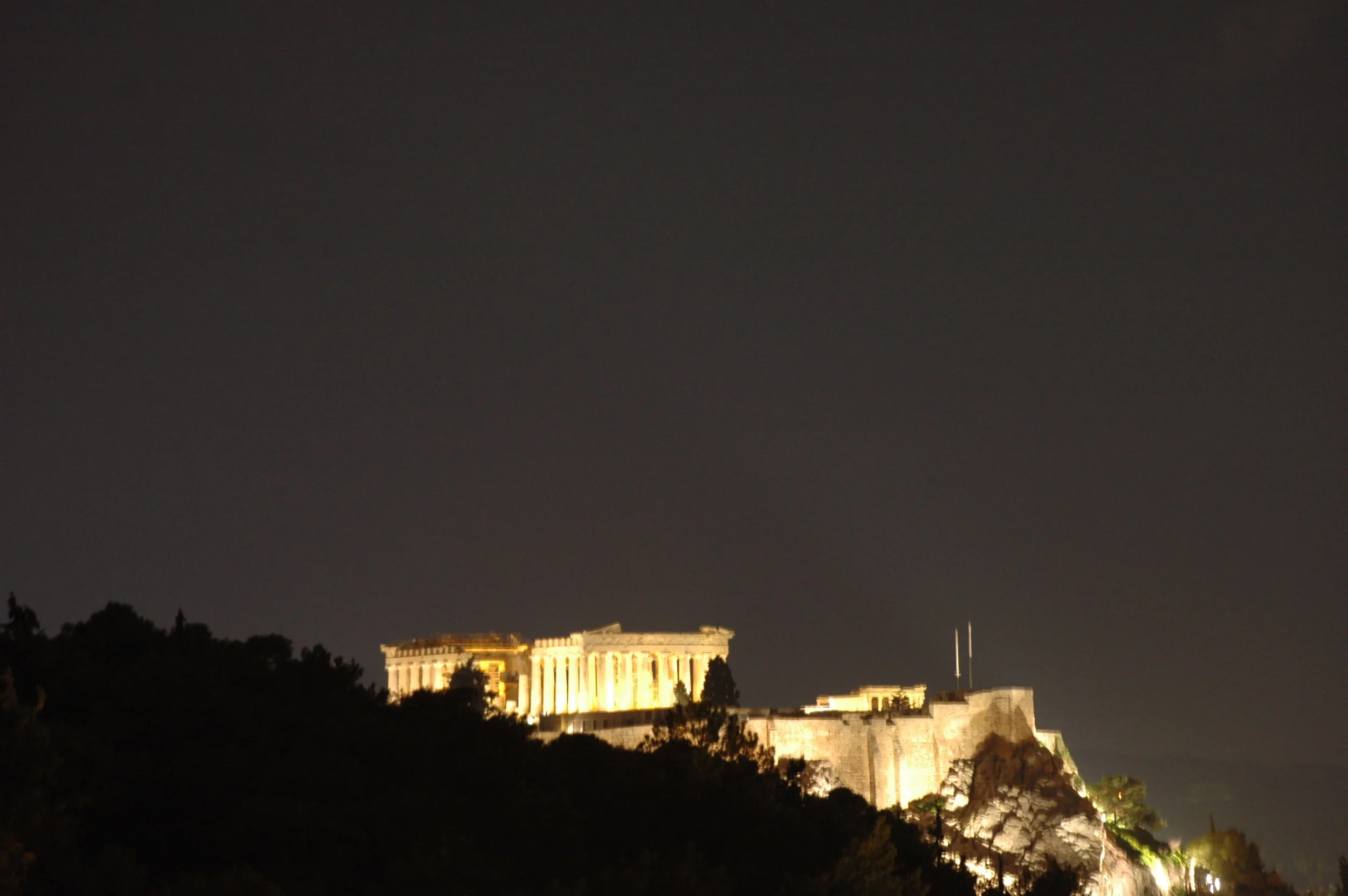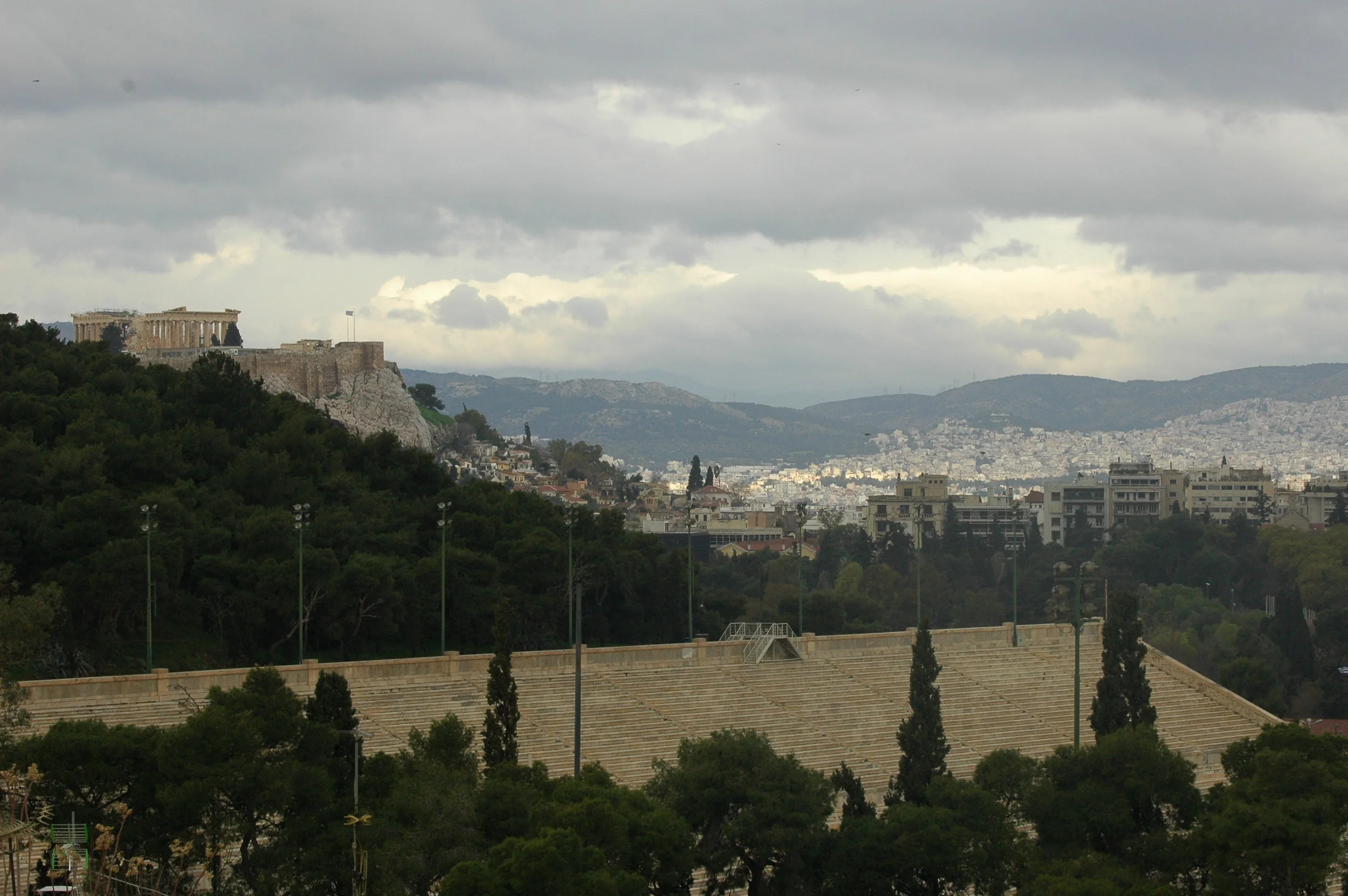Cretan Wine Tasting Experience: My Visit to Lyrarakis
It was when I found a wicker seat, out of the rain but with the light sound of it just beyond the covered patio, with a glass of water and light shining through the high-cheeked wine glasses that would soon be filled, and turning around to see the snail going in laps around the barrel top, trying to get back to the gray soil that I finally began to relax.
The Lyrarakis winery is located 30 kilometers south of Heraklion and the taxi driver needed to call his wife and ask for directions. She grew up nearby the village Alagni. It’s a cloudy day and the clouds passing through the Lasithi mountains have that sky-is-falling look — where it’s not raining here but on the horizon. The road curves through the mountains and it reminds me of driving in the blue-gray bruisy mountainsides in Northern California. The region, known as Psarades, is home to many wine cellars. Psarades refers to the gray soil, but the sommelier I’d soon meet would tell me many Greeks confuse it with Psará — fisherman.
Moving to Europe is a privilege the company I work for allowed. Although based in California, our team is all over the world and the company culture is very supportive of the traveling spirit. We make hotel software. We should love to travel, right? Plus, many of our engineers are based in Ukraine and the time difference between California and Eastern Europe became untenable after a year and a half. I also moved to Greece because my time here in college charmed and inspired and challenged me. I wanted to give it another try after having a little more experience under my belt. Because I’m here for work, when I go on adventures I do the same thing I did at home — I think about work until enough distance is between me and it that I can finally settle into the things that interest me most.
The Potters love wine. At the holidays we consume cases of it — starting early in the day with much savoring, and into the night we are still standing around the center island in the kitchen, telling stories, nibbling at leftover cheese, turning up the music. On a few occasions we start dancing, and that’s the indicator we should all finally go to bed.
When I was in San Francisco, the closeness of Napa and Sonoma was always a source of happiness. My first trip up to wine country was with Gabe and his family to celebrate his 21st birthday. He remarked on the tourism centered around a whole bunch of farms growing sauvignon blanc, chards and zins: “Isn’t it remarkable that an entire valley can be built around the idea of savoring?”
Savoring shouldn’t be so hard to do. The truth is I really didn’t know much about Greek wine. In the United States it’s very difficult to find Greek wines — much less wine from Crete. So I signed up for a private tasting with a sommelier to learn as much as I could about Cretan wine.
Anna, the sommelier-tour guide at Lyrarakis, brought a plate of crackers, rusks, thin breadsticks, along with local cheeses and a scattering of dried fig. We were to begin with a white wine — Plyto. I love when a cold glass is wrapped in condensation as a cool wine swashes and whips. A very light, almost clear yellow. Green hints. I smell the glass and am met with the bright crisp notes of citrus blossoms, the intense pucker-inducing smack you hope for on a bright sunny day. And even though it’s raining today, the mind goes to summer. Maybe there’s a pool or a novel that gripped you with a simple plot.
Sitting under the covered patio, I look out to the actual plot where these grapes grew. But today the vines are bare, serpentine — like gorgon hair. Only the first plucky shoots are poking out the bramble. Plyto — thin-skinned grape that it is, prone to sunburn — is unique to Crete. By the 1990s when the Lyrarakis brothers began growing it, the plant was nearly extinct. For generations, Cretans have been growing wine. In more recent decades these farms had become liabilities for many families. It wasn’t disease that wiped out Plyto, Anna explains. Rather, families sold their farms and the grapes in higher demand moved in. Grapes are grafted, pruned, planted. They’re cultivated, harvested, oaked. Bottled, shipped. The cost of getting started is prohibitive to most businesses and economics really didn’t favor this light green pearl until the Lyrarakis brothers pioneered it. Now Plyto flourishes again on its native island, where I enjoy it very, very slowly.
This theme of championing indigenous grapes would come up many times throughout the afternoon. Anna told me about the Melissaki grape — a grape that the Lyrarakis brothers had only read about in wine archives. Neither of them had ever seen it. No one making wine in that time had. And then it was found. As I turned my glass, I thought of the archaeologists who read myths of the ancient Minoans and then set out to find the palace at Knossos.
The next bottle is a grape called Dafni. Plyto and Dafni were the two flagship wines when the brothers started — and both were nearly extinct. Anna pours a glass and it’s the bright gold color I’m used to seeing in a chardonay. She tells me most wines get this color from the oak barrels, but Dafni is different. Unlike the Plyto, Dafni grapes have thick skins. They alone color the wine I was about to drink.
When I brought the glass to my nose it shocked the hell out of me. I was expecting oak, vanilla, maybe some stone fruit. What I got was —bittersweet — was grapeskin. The peripheral redress of spices, a spark of ginger. Dafni, in Greek, means laurel, which is an appropriate name for a wine redolent of herbs and flowers. I was suddenly thinking of artichokes. It was the most unusual wine I’ve ever tasted. As I finished I only wished I could try it again for the first time.
After a few glasses of wine — I’ll note, they gave me a glass of sparking before I started — the tasting becomes more about storytelling than picking up on every last delicate note. I can’t remember exactly what Thrapsathiri Armi tasted like, yet that word Armi stuck with me. Armi. Of course in English I think Army, and then day dream about the militant characters by the bards and historians of Ancient Greece — Homer and Herodotus. In the Cretan dialect it’s funny the word should also suggest hardened characteristics. The word describes the top of a mountainside where grapes are grown at 500 meters.
I ate cheeses and rusks as Anna told me about the practice of grafting. Vines are grafted so they can be moved and improved. “My father,” she began, “May be frustrated by the bitter oranges growing in his yard. He can graft a different orange tree and begin producing new sweet-tasting oranges without planting a new tree.”
I marveled at how Greek her example was: Ordinary man wanted better oranges. He beheads one organism, and forces that head on the body of another, as the eagle head and wings might be grafted on top of a lion to make the griffon — or, the sweet oranges, as it were.
I laughed aloud at this thought. I was beginning to feel what the Greeks call kefi — which is kind of like “tipsy” but is also more precious than that. It is to say engaged in the liveliness after much wine and the mind is feeling philosophical and joyful — but not drunk.
To the south of the Lyrarakis cellars are the Dikti mountains. With the weather like it is the white-topped mountains go in and out of view. Filling the air is a blinding silver brilliance. The light in Greece is often said to be superior and it makes a case for itself this afternoon.
We move on to a Rosé — Liatiko — bone dry, pink as it is. This one is also a mountain wine, grown at 800 m on Mt Kedros. As Anna tells me how well it would pair with goat, or even a Thanksgiving Turkey, I realize I’ve been drinking for 2 straight hours and we haven’t even gotten to the red wines yet. This wasn’t necessarily a problem, but the taxi driver who brought me here said he could wait for 2 hours or so while I took the tour. I drank some water and told Anna I just needed a moment with the taxi driver. I also brought my wallet. Even though this is Greece and many people are used to schedules running late — one of the crudest things you can do is take advantage of someone’s hospitality. Zeus punishes those men. I apologized to the driver and said it may go on another 2 hours. He looked disappointed. “I’m sorry,” he said. “I just can’t lose money.” I pulled out my wallet and paid him what he was expecting to earn on the ride back to Heraklion, which I hope assuages the boredom. We shook hands and I waved as he turned the car around and drove off.
When I returned to the patio there was a plate of local meats. Cubed pastrami with large peppercorns. Cuts of pork belly and pork shoulder. These, along with doll-sized dishes filled with olives and sundried tomatoes, all indicated it was time to switch to Reds.
Reds are my preferred wine. I told Anna this at the beginning. However, I noticed when going out to eat in Heraklion that other diners were almost always drinking white wine. Anna explained this is due to the climate. White wines grow much better in Crete’s climate and soil. Also, even though Crete wears a humid chill all winter, the island is as close to Africa as it is Europe. The summer days are long and hot, and the collective pallete — even the reds — is developed with these summers in mind.
Since Cretans prefer lighter wines, many are entirely bemused by the Mandilari grape.
Mandilari is a big, powerful, thick-skinned grape — not so unlike Cretans. It’s packed with tannins and the island’s palette never adjusted to the dry dry dry taste. Locals dismiss the grape as Vafias, which comes from Vafo, or the word for painting because most Cretan wineries only use the grape in small doses to darken an otherwise light red wine.
About 15 years ago Lyrarakis began to do more with Mandilari, always in highly selective cultivation, a low-yield harvest.
Anna poured me a glass of Mandilari from a bottle. Even though the wine is a single grape, from a single region, Lyrarakis stores the wine in two different barrels and later blends them until the taste is more balanced. Some of the wine was stored in French Oak, and some of it in American. Anna told me to take my time. That when I finished this glass we’d go into the cellar and take a taste from both the French and American barrels. My eyes widened. It was undoubtedly the most decadent thing I’d ever been invited to do. I swished the wine around in my mouth and swallowed. There was a peppery aftertaste — I closed my eyes. It was like peppercorns in the dish before me.
As we walked inside Anna told me that tasting wine is more about memory than anything else. She tries not to share too much about the profile of the wine as she tastes it — lest she influence the guest to think she tastes something she does not. We entered the cellar through glass doors and approached the barrels that were side by side. The barrels were marked with the dates when they were filled. It was just a few weeks short of being a full calendar year. Anna pulled out a glass straw called a thief which she would dip into the barrel and extract the wine. We started with the American oak.
Besides the obvious difference, American barrels are distinct from their French counterparts by how they’re prepared. Americans sanitize and wash the barrels and then quickly dry them in an oven (of sorts). On the other side of the world, French barrel makers also clean the barrels but then take them out into nature to air dry.
I know it’s just barrels but I wrinkled my nose, embarrassed at how industrial the American ones sounded.
Anna passed me a half pour of the Americanized Mandilari. I swished the glass and put my nose in it but I have no clue what I smelled. I was giddy at what I just witnessed. For the first time while Anna was speaking I pulled out my phone and took pictures. I told Anna how glad I was to be there. I flicked the glass once more and brought the wine to my lips. It was unexpectedly sharp. All I could think of was a wooden tongue depressor. Now Anna was smiling: “It’s intense, isn’t it?”
I started laughing. Anna shared a story about a couple from Texas who visited the winery and took the same tour as me. They said the American oak was bold, in-your-face (and then I realized where she was going) — like an American.
“And the French oak… oh, well, you’ll see.” I gulped back the rest of the sample and gave her my glass. She guided the thief into the adjacent barrel made from French oak. Again I swirled the glass and brought it up to taste. It wasn’t bad — on its own it wasn’t really my style (like France) but the difference was noticeable. There was texture but it also felt weaker. The American oak was all backbone. I took another sip and paused. Was I imagining things — or was there that note of peppercorn again?
Anna told me to walk around and take pictures. She was going to prepare a few final touches for the remaining tastings. And so I did. These were my final days in Greece. On Monday I’d resume work, taking meetings, and generally trying to solve problems. A week from now I’d be moving to a new city. It seemed fitting that one of the last memories for awhile would be slow and full of savoring. That it should include lessons on memory and history, and over and over I was reminded of Greek lyrics, epics, I couldn’t help but think of the Muses. I take a breath. My instinct is always to narrativize and find symbolism. Sometimes it’s just a daydream getting the best of me. But some days — what’s the harm.
I met Anna back in the main tasting room. The final red in my flight was a limited release of their best vintage. Most years they don’t make it. They call the wine Symbolo, a blend of Syrah, Mandilari, and Merlot. The glass had been left to breathe for perhaps 45 minutes and was now beneath my nose. She asked me to look at it squarely from above and see just how dark the wine was. Bottomless like the sea at night.
Sometimes exchanges with Greeks leave me breathless and puzzled for days. Countless times I walked down the street and muttered to myself, How strange. After discussing Symbolo, the vintage, their selection process, the pictographic letters of the Ancient Minoans known as “Linear B” and a light tangent on my love for the Greek alphabet, Anna said we’d need to discuss some logistics. Because I sent home the original cab 2 hours ago, she could call another taxi for me now or, if I was okay with it, their Marketing coordinator Katerina could drive me back to the city.
After such a delight of an afternoon, their continuous generosity took the top of my head clear off. I blinked and fell back into my chair — stunned — and then was thanking her and apologizing profusely. We were all laughing but somehow I still think I was the only one who thought this was astonishing.
Being in Greece feels like nowhere else I’ve ever been. After telling me several times it really was okay, they asked if they could bring me another glass of wine while they closed up shop. And they did, and then Katerina drove me back up to Heraklion. As we got into the car I asked how long she’d been working with Lyrarakis. It was her first day.

